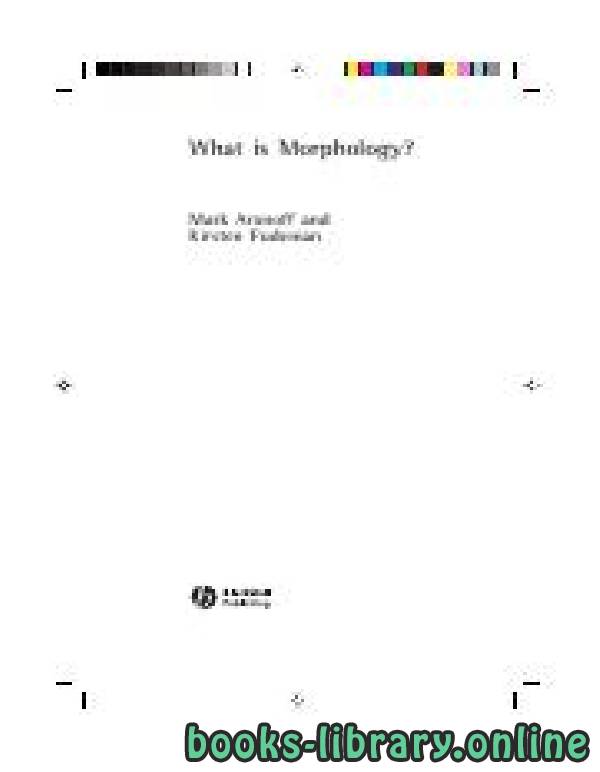📘 قراءة كتاب What is Morphology? أونلاين


هذا القسم يحتوي علي كل ما يخص بعلم الصرف
يتوفر علم الصرف على تبيان تأليف الكلمة المفردة بتبيان وزنها وعدد حروفها و حركاتها و ترتيبها، و ما يعرض لذلك من تغيير وحذف، وما في حروفها و حركاتها و ترتيبهما، وما في حروف الكلمة من اصالة و زيادة.
يقتصر مجال دراسات الصرف على الأسماء المتمكنة (المعربة) و الافعال المتصرفة (غير جامدة).
أما الحروف و مبنيات الأسماء و جوامد الافعال، فلا تدخل في مجال دراسته و أبحاثه.
يُعرَفُ الصرف أيضا بعلم التشكل (باللاتينية: Morphologia). والصرف لُغَةً هو التغير والتحويل ومنه تصريف الرياح أي تغيير وجهتها من مكان لآخر.
In linguistics, morphology (/mɔːrˈfɒlədʒi/) is the study of words, how they are formed, and their relationship to other words in the same language. It analyzes the structure of words and parts of words, such as stems, root words, prefixes, and suffixes. Morphology also looks at parts of speech, intonation and stress, and the ways context can change a word's pronunciation and meaning. Morphology differs from morphological typology, which is the classification of languages based on their use of words, and lexicology, which is the study of words and how they make up a language's vocabulary.]
While words, along with clitics, are generally accepted as being the smallest units of syntax, in most languages, if not all, many words can be related to other words by rules that collectively describe the grammar for that language. For example, English speakers recognize that the words dog and dogs are closely related, differentiated only by the plurality morpheme "-s", only found bound to noun phrases. Speakers of English, a fusional language, recognize these relations from their innate knowledge of English's rules of word formation. They infer intuitively that dog is to dogs as cat is to cats; and, in similar fashion, dog is to dog catcher as dish is to dishwasher. By contrast, Classical Chinese has very little morphology, using almost exclusively unbound morphemes ("free" morphemes) and depending on word order to convey meaning. (Most words in modern Standard Chinese ["Mandarin"], however, are compounds and most roots are bound.) These are understood as grammars that represent the morphology of the language. The rules understood by a speaker reflect specific patterns or regularities in the way words are formed from smaller units in the language they are using, and how those smaller units interact in speech. In this way, morphology is the branch of linguistics that studies patterns of word formation within and across languages and attempts to formulate rules that model the knowledge of the speakers of those languages.
Phonological and orthographic modifications between a base word and its origin may be partial to literacy skills. Studies have indicated that the presence of modification in phonology and orthography makes morphologically complex words harder to understand and that the absence of modification between a base word and its origin makes morphologically complex words easier to understand. Morphologically complex words are easier to comprehend when they include a base word.[6]
Polysynthetic languages, such as Chukchi, have words composed of many morphemes. The Chukchi word "təmeyŋəlevtpəγtərkən", for example, meaning "I have a fierce headache", is composed of eight morphemes t-ə-meyŋ-ə-levt-pəγt-ə-rkən that may be glossed. The morphology of such languages allows for each consonant and vowel to be understood as morphemes, while the grammar of the language indicates the usage and understanding of each morpheme.
The discipline that deals specifically with the sound changes occurring within morphemes is morphophonology.
Contents
1 History
2 Fundamental concepts
2.1 Lexemes and word forms
2.1.1 Prosodic word vs. morphological word
2.2 Inflection vs. word formation
2.3 Types of word formation
2.4 Paradigms and morphosyntax
2.5 Allomorphy
2.6 Lexical morphology
3 Models
3.1 Morpheme-based morphology
3.2 Lexeme-based morphology
3.3 Word-based morphology
4 Morphological typology
5 Examples
6 Application
What is Morphology?
Mark Aronoff and
Kirsten Fudeman
Thinking about Morphology and
Morphological Analysis
1.1 What is Morphology? 1
1.2 Morphemes 2
1.3 Morphology in Action 4
1.3.1 Novel words and word play 4
1.3.2 Abstract morphological facts 6
1.4 Background and Beliefs 9
1.5 Introduction to Morphological Analysis 12
1.5.1 Two basic approaches: analysis and synthesis 12
1.5.2 Analytic principles 14
1.5.3 Sample problems with solutions 17
1.6 Summary 21
Introduction to Kujamaat Jóola 22
mor·phol·o·gy: a study of the structure or form of something
Merriam-Webster Unabridged
n 1.1 What is Morphology?
The term morphology is generally attributed to the German poet, novelist,
playwright, and philosopher Johann Wolfgang von Goethe (1749–1832),
who coined it early in the nineteenth century in a biological context. Its
etymology is Greek: morph- means ‘shape, form’, and morphology is the
study of form or forms. In biology morphology refers to the study of the
form and structure of organisms, and in geology it refers to the study of
the configuration and evolution of land forms. In linguistics morphology
refers to the mental system involved in word formation or to the branch
Morphology
Morphology
morphology examples
morphology تعريف
types of morphology
morphology شرح
morphology linguistics summary
morphology pdf
english morphology
morphology and syntax
What is Morphology? - Mark Aronoff, Kirsten Fudeman
سنة النشر : 2014م / 1435هـ .
حجم الكتاب عند التحميل : 0.9MB .
نوع الكتاب : pdf.
عداد القراءة:
اذا اعجبك الكتاب فضلاً اضغط على أعجبني و يمكنك تحميله من هنا:

شكرًا لمساهمتكم
شكراً لمساهمتكم معنا في الإرتقاء بمستوى المكتبة ، يمكنكم االتبليغ عن اخطاء او سوء اختيار للكتب وتصنيفها ومحتواها ، أو كتاب يُمنع نشره ، او محمي بحقوق طبع ونشر ، فضلاً قم بالتبليغ عن الكتاب المُخالف:
 قبل تحميل الكتاب ..
قبل تحميل الكتاب ..
يجب ان يتوفر لديكم برنامج تشغيل وقراءة ملفات pdf
يمكن تحميلة من هنا 'http://get.adobe.com/reader/'


 منصّة المكتبة
منصّة المكتبة 